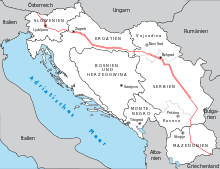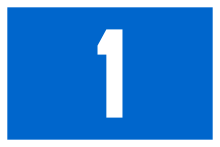Brotherhood and Unity Highway
The Brotherhood and Unity Highway (Croatian: Autocesta "Bratstvo i jedinstvo"; Macedonian: Автопат „Братство и единство“; Slovene: Cesta bratstva in enotnosti or Avtocesta bratstva in enotnosti, Serbian: Autoput "Bratstvo i jedinstvo", Аутопут "Братство и јединство"), officially classed as the M-1 Highway, was a highway that stretched over 1,182 km (734 mi)[1] across Yugoslavia, from the Austrian border at Rateče near Kranjska Gora in the northwest via Ljubljana, Zagreb, Belgrade and Skopje to Gevgelija on the Greek border in the southeast. It was the main modern highway in the country, connecting four constituent republics.


History
Construction began on the initiative of President Josip Broz Tito, who called the project the "Road of brotherhood and unity" (Autoput bratstva i jedinstva) after the motto of the League of Communists of Yugoslavia. The first section between Zagreb and Belgrade was built with the effort of the Yugoslav People's Army and volunteer Youth Work Actions and was opened in 1950. The section between Ljubljana and Zagreb was built by 54,000 volunteers in less than eight months in 1958.[2] The southern section from Belgrade was not completed until the mid-1960s.
Its importance caused it to be colloquially named autoput or autocesta (generic Serbo-Croatian expressions for "highway", "motorway"). This use has since largely faded out, after the successor states built further motorways.
In the 1960s and 1970s the autoput became a much frequented holiday route for Turkish immigrants in West Germany and Austria (then called Gastarbeiter) visiting their original homeland during the summer vacation time, and for tourists to southeastern Europe. Entering communist but non-aligned Yugoslavia was far easier, for people from NATO countries such as West Germany and Turkey, than entering any of the Warsaw Pact communist countries of the Balkan region that might have provided alternative routes.
Originally an ordinary road, the carriageway used to be congested with cars and trucks, especially in summertime, when overtired long-distance drivers caused numerous accidents. Wrecked cars usually remained in place for long periods of time, providing a grim reminder of the dangers of the highway. The situation slightly improved after some parts were brought up to modern motorway standards (two lanes for each direction plus an emergency lane) on the following sections built between 1977 and 1991:
- Kranj–Ljubljana: 20 km (12 mi)
- Jankomir interchange (Zagreb bypass)–Slavonski Brod (east): 207 km (129 mi)
- Sremska Mitrovica–Belgrade–Niš: 277 km (172 mi)
In 1991, several sections were affected by the Yugoslav wars, bringing severe damage, and causing the traffic to be almost completely discontinued in places.
International categorization
Since 1975, the road was concurrent with the following routes of the International E-road network:
- European route E61: Villach–Kranj–Ljubljana
- European route E70: Ljubljana–Zagreb–Sisak–Slavonski Brod–Belgrade
- European route E75: Belgrade–Niš–Skopje-Veles–Thessaloniki
Legacy
Since 1994 the route is also part of the Pan-European corridor X that extends from Salzburg to Thessaloniki.
The road has been continuously upgraded. As of 2019, it is a modern motorway in its entire length through:
- Slovenia - the A2 motorway;
- Croatia - the A3 motorway;
- Serbia - the A3 motorway west of Belgrade and the A1 motorway south of Belgrade.
- North Macedonia - the A1 motorway.
The most difficult section to engineer and build was the 34 km (21 mi) Grdelica Gorge section which was completed in May 2019. The classification as the M-1 Highway continued in Serbia up to 2013, when the road was reorganized as the A1 and A3.
References
- Sić 1990, p. 23.
- Lubej, Uroš (28 November 2008). "Nova razstava v Dolenjskem muzeju: Cesta, ki je spremenila Dolenjsko" [The New Exhibition in the Lower Carniolan Museum: The Road that Transformed the Lower Carniola]. Park.si (in Slovenian). Archived from the original on 15 June 2018. Retrieved 20 August 2013.
Sources
- Sić, Miroslav (June 1990). "Problematika razvoja autocesta u Hrvatskoj i Jugoslaviji na pragu 90. godina" [Development of Motorways in Croatia and Yugoslavia on the Threshold of the Nineties] (PDF). Geografski glasnik (in Croatian). 52 (1): 13–29. Retrieved 13 December 2015.CS1 maint: ref=harv (link)
External links
